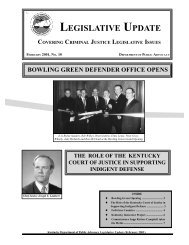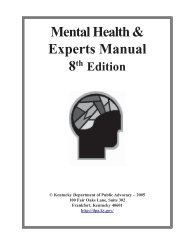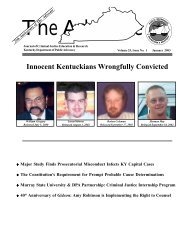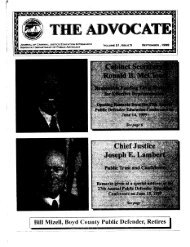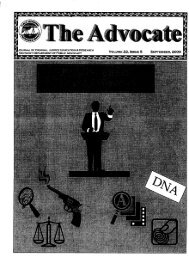May 2002 - Department of Public Advocacy
May 2002 - Department of Public Advocacy
May 2002 - Department of Public Advocacy
Create successful ePaper yourself
Turn your PDF publications into a flip-book with our unique Google optimized e-Paper software.
Continued from page 41<br />
helped to impeach the testimony <strong>of</strong> Buchanan, Tamme’s codefendant<br />
who had turned state’s evidence. In finding that<br />
the evidence should have been presented at trial, the trial<br />
court used the incorrect legal standard and then mixed standards<br />
for deciding RCr 10.02/10.06 and RCr 11.42 motions.<br />
The trial court indicated that the test for RCr 10.02/10/06 motions<br />
is whether the testimony <strong>of</strong> the newly discovered witness<br />
“could reasonably result in a different verdict and<br />
whether the testimony could be reasonably persuasive as a<br />
part <strong>of</strong> the entire defense theory.” Tamme III, slip op. at 5. The<br />
correct standard is whether the testimony would “with reasonable<br />
certainty” change the verdict or “probably change<br />
the result” in a new trial. Id., citing Collins v. Commonwealth,<br />
Ky., 951 S.W.2d 569 (1997).<br />
Regarding the trial court’s second error, the Court found no<br />
precedent for the mixing <strong>of</strong> standards for deciding RCr 10.02/<br />
10.06 and RCr 11.42 motions. The trial court itself admitted<br />
that the newly discovered evidence, when not considered in<br />
conjunction with ineffective assistance <strong>of</strong> counsel, would<br />
not meet the standard for granting a new trial.<br />
KELLER CONCURRENCE<br />
Justice Keller, joined by Chief Justice Lambert, agreed that<br />
the trial court erred and with the Court’s analysis regarding<br />
mixed standards. He agreed with the majority that Tamme did<br />
not meet his burden <strong>of</strong> pro<strong>of</strong> under Strickland v. Washing-<br />
THE ADVOCATE Volume 24, No. 3 <strong>May</strong> <strong>2002</strong><br />
ton, 466 U.S. 864 (1984), wrote separately regarding the Tamme<br />
I issue because <strong>of</strong> his belief that the majority improperly applied<br />
the law <strong>of</strong> the case doctrine.<br />
The paragraph from Tamme I, found at 52-54, which the majority<br />
apparently used to come to its conclusion did not address<br />
the question <strong>of</strong> whether the evidence was admissible<br />
for all purposes, including whether Tamme could use the<br />
information as impeachment. In other words, the use <strong>of</strong> such<br />
information as impeachment was left open. Application <strong>of</strong><br />
the law <strong>of</strong> the case doctrine must rest on more than mere<br />
speculation. “Simply put, the law <strong>of</strong> the case doctrine is not<br />
applicable when a subsequent trial presents different facts,<br />
issues, or evidence.” Id., citing 5 Am. Jur. 2d Appellate Review<br />
§611 (1995).<br />
ENDNOTES<br />
1. Carter v. Kentucky, 450 U.S. 288 (1981)<br />
2. One <strong>of</strong> her answers on the jury questionnaire was that<br />
“she did not trust anyone.”<br />
Julia K. Pearson<br />
Capital Post-Conviction Branch<br />
<strong>Department</strong> <strong>of</strong> <strong>Public</strong> <strong>Advocacy</strong><br />
100 Fair Oaks Lane, Suite 301<br />
Frankfort, KY 40601<br />
Tel: (502) 564-3948 Fax: (502) 564-3949<br />
E-mail: jpearson@mail.pa.state.ky.us<br />
The 100th Wrongfully Convicted Inmate is Free<br />
After Ten Years, Escaping the Death Penalty:<br />
The Constitution Project Urges Death Penalty Reforms Now<br />
On Monday, Ray Krone walked out <strong>of</strong> an Arizona prison not<br />
only exonerated <strong>of</strong> the murder charges against him, but with<br />
DNA evidence pointing almost certainly to another person.<br />
He becomes the 100th death row inmate to be exonerated<br />
since the death penalty was reinstated in 1973.<br />
Mandatory Justice: Eighteen Reforms to the Death Penalty<br />
was developed by the Constitution Project’s blue-ribbon,<br />
bipartisan committee that is the first nationwide group to<br />
achieve consensus on comprehensive death penalty reforms.<br />
One <strong>of</strong> the recommendations in Mandatory Justice speaks<br />
directly to the ‘preservation and use <strong>of</strong> DNA evidence to<br />
establish innocence or avoid unjust execution. In most jurisdictions,<br />
the legal structure is not adequate to take proper<br />
advantage <strong>of</strong> the advances in scientific testing <strong>of</strong> evidence.’<br />
The Committee recommends that legislation dictate the preservation<br />
<strong>of</strong> biological samples in all death penalty cases and<br />
should require testing upon defense request. In many instances<br />
the lack <strong>of</strong> legislation has resulted in destruction <strong>of</strong><br />
crucial evidence.<br />
There is also urgent need for the guarantee for effective defense<br />
lawyers, prohibition <strong>of</strong> the execution <strong>of</strong> defendants who<br />
were juveniles at the time <strong>of</strong> the crime and the mentally retarded,<br />
expansion <strong>of</strong> the possibilities for life without parole,<br />
safeguards to assure racial fairness, and better definition <strong>of</strong><br />
the role <strong>of</strong> judges, juries and prosecutors.<br />
The Committee includes proponents and opponents <strong>of</strong> the<br />
death penalty; victim advocates; prosecuting and defense<br />
lawyers; prison <strong>of</strong>ficials; judges and scholars. The committee’s<br />
co-chairs are Beth Wilkinson, the prosecutor in the Oklahoma<br />
City bombing case; the Honorable Charles F. Baird, former<br />
Judge, Court <strong>of</strong> Criminal Appeals <strong>of</strong> the State <strong>of</strong> Texas; and<br />
the Honorable Gerald Kogan, former Chief Justice, Supreme<br />
Court <strong>of</strong> the State <strong>of</strong> Florida and former Chief Prosecutor,<br />
Homicide and Capital Crimes Division, Dade County, Florida.<br />
Constitution Project Executive Director Virginia Sloan, says,<br />
“One-hundred people are pro<strong>of</strong> that the system is not working.<br />
It’s time for Americans to demand reform in the name <strong>of</strong><br />
accuracy, fairness and justice. No matter whether we support<br />
or oppose capital punishment, we cannot allow the system to<br />
make another mistake.”<br />
42



